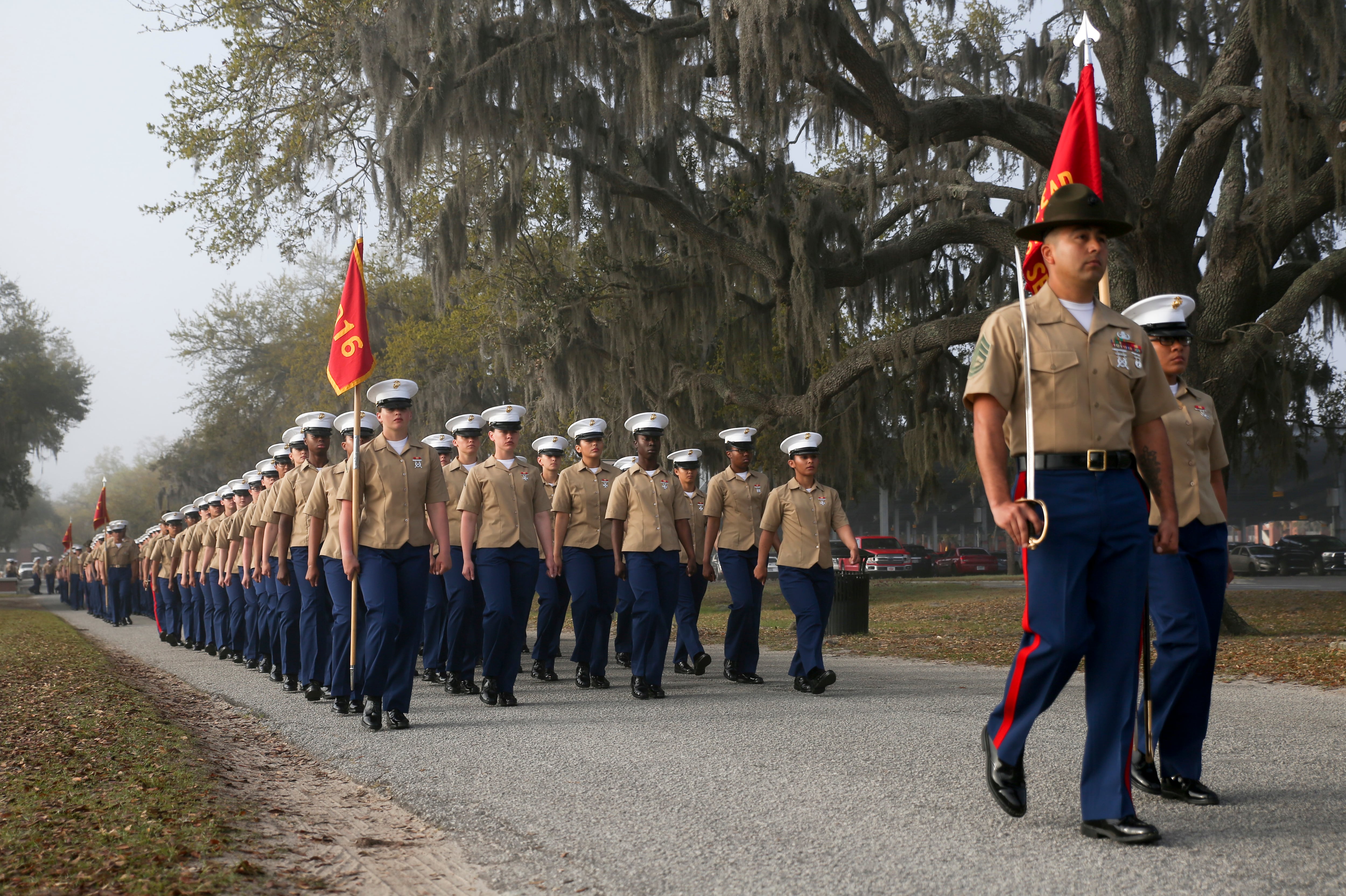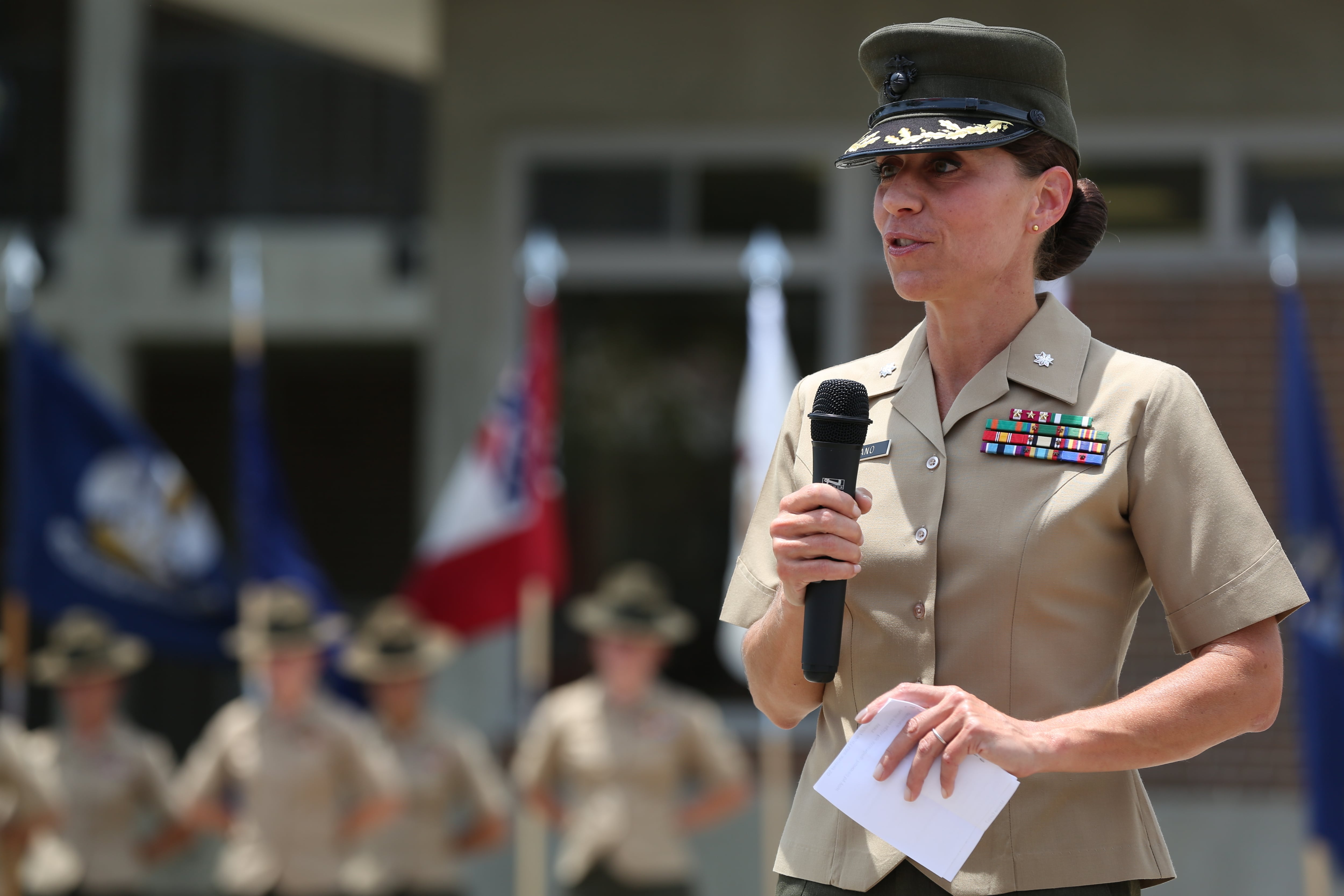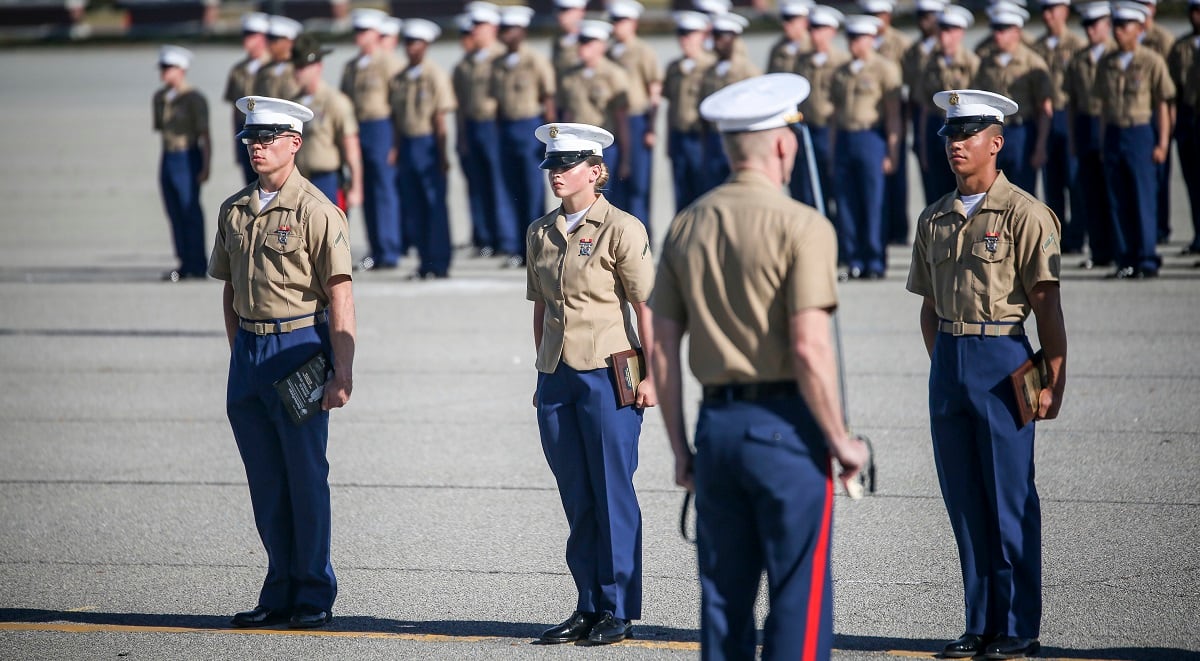As the only service that remains separated by gender in basic training, the Marine Corps is now looking for a university study on what it would take and what would change if the Corps moved to coed recruit training.
The wanted study, according a federal business contracting website, will include the “extent and effectiveness of gender-combined recruit training and possible options to increase gender-integrated training during boot camp.”
This posting, first reported by Military.com, follows a summer push by Congress to integrate genders in training.
In June, members of the House Armed Services Committee voted to pass a plan that would require the Corps to integrate training within five years.
RELATED

The study has a due date of Feb. 1, 2021.
The study does not demand full, side-by-side gender integration at recruit training. It calls only for integrating after the first phase of recruit training and for the remainder of the 13-week training. Integration will only be at the series level, not in platoons.
Since January, at least three Marine recruit training classes have seen all-male and all-female recruit platoons training side-by-side in ways that had never before been allowed.
Each company has had male and female recruits share the same barracks, with each platoon having its own squad bay for Marines to sleep, shower and do platoon and individual training.
When the companies come together for physical training, the obstacle course or the many hours of classroom study, female and male platoons will be side by side, Marine Corps Times previously reported.
The scope of the report will include the following measures:
- Determine alternatives to the current recruit training approach in use by the Marine Corps.
- Determine costs associated with gender-separated and gender-integrated training.
- Determine costs associated with identified training alternatives. (Costs can be fiscal, in terms of military construction costs, as well as potential costs to the Marine Corps’ service legacy.)
- Determine if, and if so, how, perceptions about gender-integrated training factor into recruit decisions about joining or not joining the Marine Corps.
‘Potential costs’
While the notice appears to be a step toward integrating Marine training, some still see language in the posting as hurting efforts from the outset.
Retired Marine Lt. Col. Kate Germano told Marine Corps Times that the four-page document is riddled with areas that are, “essentially broadcasting the intent of the study.”
Those include a statement in the scope of the study that asks researchers determine “potential costs to the USMC’s service legacy.”
“I can’t even express how negative a statement that is,” Germano said.
Germano served both in Marine Corps recruiting and as a commander of the female recruit 4th Recruit Training Battalion in Parris Island, South Carolina. She was relieved from that position in 2015 for leading a “hostile, unprofessional and abusive” command.

But both at the time and since her retirement, Germano has defended her leadership, pointing to how she says she held female recruits to higher standards and saw vast improvements in their performance. She later authored the book, “Fight Like a Girl,” outlining her experience and deep inequities in how training was conducted for female recruits.
Since then, the Marine Corps has adopted some of her training methods.
A deeper problem, Germano noted, is that the study proposal does not anticipate a growth in the number of female recruits to join the Marines.
The proposal expects that the number ― an estimated 3,000 new female recruits annually ― “is anticipated to remain static,” according to the posting.
It hints at an issue that precedes recruit training: efforts by the Marine Corps to recruit female Marines in the first place.
“The Marine Corps has never had any concrete evidence or study to support that there is not a propensity of high school girls to join the Marine Corps,” Germano said.
Integrated training
This is not the first time the Corps has been pushed to integrate training for male and female recruits.
In 2015, then-Secretary of the Navy Ray Mabus, sent a memo to then-Marine Corps Commandant Gen. Robert Neller to come up with a plan to integrate recruit training. But Neller chose to meet one-on-one with then-Secretary of Defense Ash Carter.
That seemed to have squashed Mabus’ plan.
Following the meeting, the Marine Corps was no longer required to integrate fully but instead to look at increasing opportunities for male and female Marines to train together.
RELATED

About 65 to 75 percent of training aboard Parris Island, South Carolina, has males and females working together, Neller later said in 2018.
Neller described the training of Marines by platoon as the “most effective way to make Marines,” Marine Corps Times previously reported.
“And I am not considering having recruits fall out and go from one platoon to another.”
In January 2019 Neller announced that a female platoon would train more beside male platoons in an integrated company, but said he would not approve integrating male and female recruits within the platoon.
In April, then-incoming Commandant Gen. David Berger told Congress during his confirmation hearing that he was open to another look at gender integration at Parris Island, South Carolina.
He said the recent effort, “went great.”
In the summer 2019 hearings, members of Congress cited the need to move forward with combining the training.
“Fully integrating women is not only the right thing to do, it makes our military stronger,” Rep. Jackie Speier, D-California, and head of the committee’s personnel panel, said in introducing the plan.
This is not the first time the Marine Corps has conducted a study or collected data on the issue.
The study wants researchers to synthesize all previous reports and studies on gender-integrated training at the Marine Corps recruiting depots, which may require interviews with Marine leadership, experts and training cadre.
The posting details 26 separate documents, some studies or research related to gender in military training. Some of those are recent, but many date to decades ago in the 1960s and 1990s.
Germano points to a number of the studies as being irrelevant as society, recruit training and types of recruits have changed in recent decades.
Some of the studies were conducted before other services integrated male and female recruits, she said.
Researchers also will be expected to do some of their work at Parris Island, South Carolina; San Diego; Quantico, Virginia; and at Army, Navy and Air Force basic training sites.
Army basic training went coed from 1978 to 1982 before returning to segregated status then going fully integrated in 1994.
Navy boot camp began coed training in 1992. The Air Force had coed initial training starting in the mid-1980s. The Coast Guard has been coed since 1973.
Both Marine Corps Officer Candidate School and The Basic School have been coed for decades.
The Naval Academy has been coed since 1976.
Todd South has written about crime, courts, government and the military for multiple publications since 2004 and was named a 2014 Pulitzer finalist for a co-written project on witness intimidation. Todd is a Marine veteran of the Iraq War.




